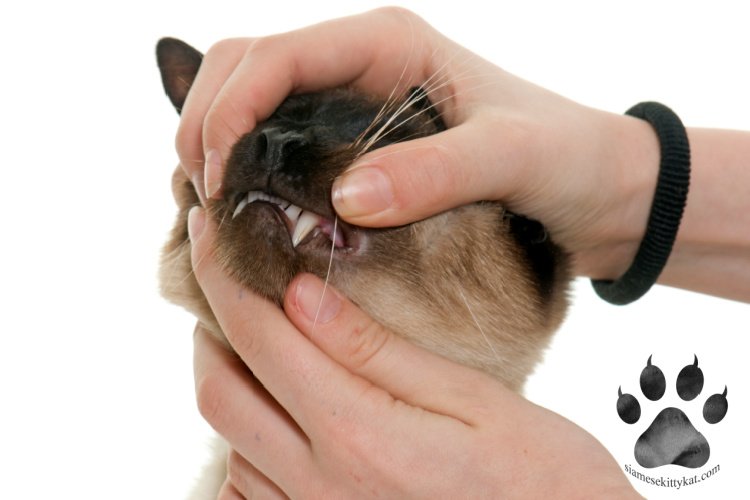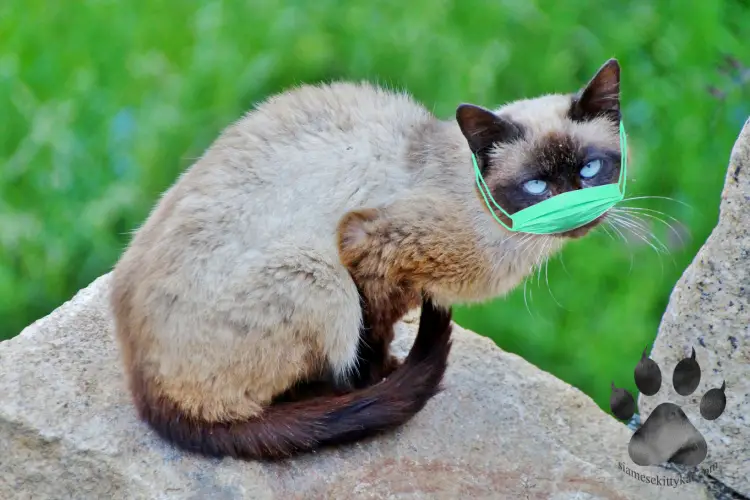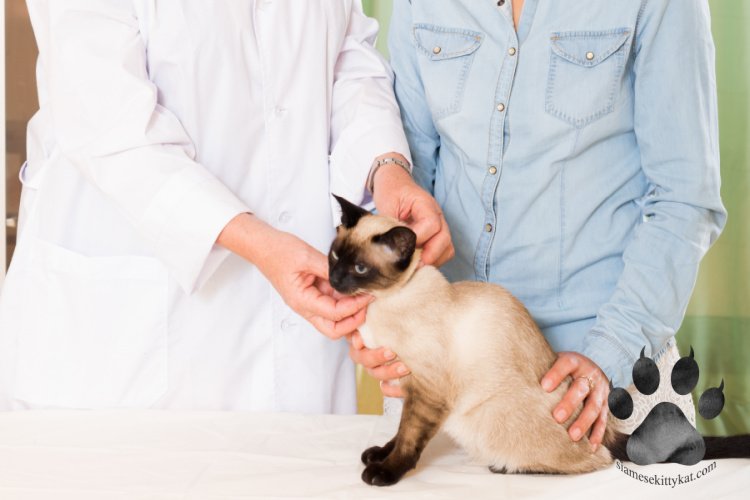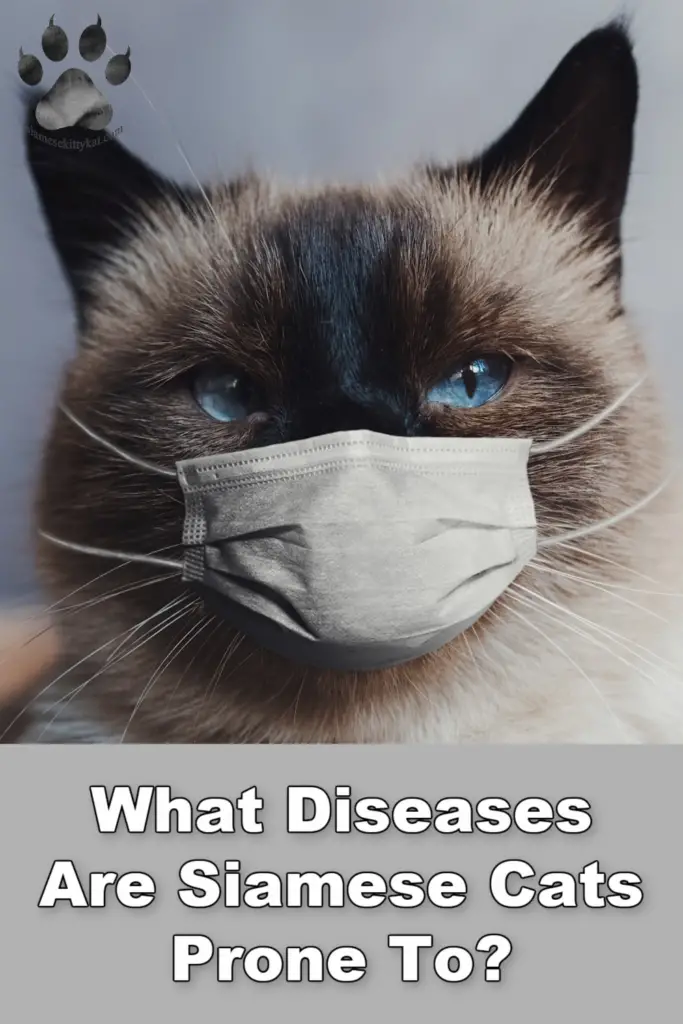Siamese cats are loved worldwide due to their impressive personality, lovable nature, and unique features. These felines have an impressive lifespan, gracing our households for 15 to a whopping 20 years.
While Siamese cats live longer than your average moggie, they are more susceptible to certain genetic diseases. Cats with a more diverse gene pool, aka mixed kitties, are usually healthier than purebred felines.
In this article, we’ll go over diseases your Siamese is prone to – taking a look at the studies done, as well as personal experiences with said diseases.
Do Siamese cats have health problems?
Generally, Siamese cats are a very healthy breed – especially when you take a look at their average life span.
However, many feline diseases and illnesses are targeted at specific breeds, making those health conditions genetic. Unfortunately, Siamese cats aren’t an exception to this rule, and they themselves are prone to several diseases.
Due to their genetic makeup, Siamese may be prone to the diseases listed below more than your average feline. However, this does not mean your Siamese has, or will, develop any of the illnesses we’re going to cover in this article.
A responsible owner simply has to prepare for any outcome when it comes to our little fur babies.
Diseases That Siamese Cats Are Prone To
Based on the studies done by expert veterinarians; we’re able to relay the information to you, making sure you know how to keep your Siamese healthy and happy for years to come!
1. Feline Lymphoma

Lymphoma, also known as Lymphosarcoma, is the most common type of cancer found within cats. Lymphoma has been associated with young age, short survival times, and the Siamese breed.
This form of cancer can be found within the lymph nodes, chest, nervous system, nose, kidneys, and intestinal tract. It’s a disease that affects the body’s ability to form white blood cells properly, therefore can appear almost anywhere in the body.
No one is quite sure why Siamese cats are prone to this disease more than other felines. However, it is suspected to be recessive in nature.
Since your Siamese is either born with this disease or not, this means there is no way to prevent this disease from forming.
But, you’ll be happy to know Lymphoma is very treatable, depending on how early you catch cancer. Chemotherapy has a great track record when it comes to treating felines.
If you’ve purchased your Siamese from a reputable breeder, you can be sure they have not used a Siamese who has or had Lymphoma for breeding.
During 1984 – 1994, over 7159 veterinary records about both healthy and sick felines were reviewed. Over this 10 year span, 60 cases of Feline Lymphoma (0.84%) made up the hospital population. [1]
Siamese cats appeared in this research, whereas other purebred felines did not. According to this case study, male cats are also more susceptible to this type of cancer than females.
Mediastinal Lymphoma – 1/4th of the anatomic categories in Lymphoma that is found in the chest area – were mostly young Siamese cats.
As a result, it was concluded that Siamese cats may have a genetic predisposition to Lymphoma due to the frequency of disease within the specific breed.
In 2017, an 8-year-old female Siamese had been taken to the vet with a 3-week history of inspiratory dyspnoea (upper airway obstruction) and open-mouthed breathing after exercise. [2]
A series of tests, including bronchoscopy and tracheostomy, were performed on the Siamese, and a mass was identified within the trachea.
After a few other tests were done in an attempt to provide a diagnosis, both brush cytology and a CT scan of the neck failed to verify the further diagnosis.
The Siamese was taken to surgery, where 7 rings of the trachea were removed so the surgeons could safely extract the mass. Once the mass was extracted, it was then examined, where it was finally determined to be Lymphoma.
You’ll be happy to know that after 3 months of chemotherapy, the Siamese showed no signs of Lymphoma recurrence, and made a healthy recovery. The same can be said 20 months since the initial diagnosis of Lymphoma.
2. Feline Asthma
Most cats that suffer from asthma are between the ages of 6 – 8 years, however, it can occur at any age. 2-5% of the felines that suffer from this form of asthma are in fact Siamese cats.
Just like asthma we suffer from, feline asthma is triggered by an irritant or allergen, causing the small airways in the lungs to narrow and inflame. Once this has been triggered, it’ll become hard for your cat to breathe properly.
Feline asthma is classed as a progressive illness, meaning the symptoms may be mild at first, but can soon develop into a life-threatening disease if left untreated.
If your Siamese is suffering from asthma, you’ll be able to tell with these signs:
You may be surprised to know there are many things you can do to prevent your Siamese from developing asthma. Obesity can worsen breathing difficulties, as can irritants around the house and changing seasons.
Putting your Siamese on a diet if overweight, and eliminating irritants around the house can significantly help.
When it comes to treating asthma, there are quite a few routes you can go down. One includes daily oral medication that works to reduce inflammation. This may also be prescribed via an injection that lasts around a month.
Feline asthma can also be treated with an inhaler, similar to the ones used for human babies. Although it sounds like a hassle, cats tend to tolerate this treatment quite well.
Even though Feline Asthma is similar to asthma in humans, there isn’t much known about the disease. Many studies conducted from 1989 through to 2004 are quite contradicting with their findings. [3]
However, one certain thing is many studies report Siamese cats are overrepresented, and prone to Feline Asthma more than your average moggie.
Siamese cats may be more severely affected and have a more progressive disease due to their breed. Feline Asthma is also common in cats from middle age and onwards, however many Siamese experiences coughing at an early age.
A few reports suggest that female cats are more prone to Feline Asthma, but this isn’t conclusive.
In 2019, a 4-year-old domestic shorthair was brought into the emergency room due to lethargicness, refusing treats, and stumbling around. [4]
Once Sparta (the feline in question) was examined, it was determined that something was blocking his airways, causing panting and breathing problems.
After a series of tests, including bloodwork and Thoracic radiographs, were conducted, veterinarians found the source of the problem. A build-up of mucus in the airways was making it difficult for air to pass into the lungs – a result of Feline Asthma.
Sparta was prescribed a medicine to open up his airways and reduce the inflammation – all administered via an inhaler.
You’ll be happy to know this kitty took to his medication like a fish to water, and since Feline Asthma can’t be cured, Sparta will have to be monitored closely for the rest of his life.
But, he’ll be healthy and happy!
3. Amyloidosis

Amyloidosis is a disease that affects how the liver functions, often leading to chronic kidney disease. The amyloid protein builds up in the liver, intestines, and kidneys.
Interestingly enough, this protein compound is similar to that which can be found in Alzheimer’s patients.
It isn’t clear why, and there is also little research on the mode of genetic transmission. However, Siamese cats record a high frequency of this specific disease.
The signs that your Siamese is suffering from Amyloidosis depend on which organ becomes affected. However, it usually happens within the kidneys.
Signs you Siamese may be suffering from Amyloidosis:
Unfortunately, there is also no way to trace amyloidosis back to the parents of the affected cat. Therefore, many breeders rely on family history before choosing Siamese cats for breeding.
Due to a lack of knowledge about the disease, there is neither a prevention nor cure for Amyloidosis. However, a strict diet and medication can be used to support the function of organs.
During a 7 year period, from 1987 – 1994, 2176 cats were examined and studied. 194 of these felines were Siamese, and 12 of these Siamese cats were diagnosed with Amyloidosis. 2 were Abyssinian cats and 13 were cats of other breeds.
Studies determined that there was a significant difference between Siamese cats and other felines concerning Amyloidosis disease. A new protein was discovered – a gene mutation only visible in Siamese cats.
This gene mutation suggests that Amyloidosis genes can be inherited from their parents, much different from the usual form of Amyloidosis. [5]
4. Feline Hyperesthesia Syndrome

Feline Hyperesthesia Syndrome (FHS) is the opposite of a drug you may know called ‘anesthesia’ – a drug used to dull the sensation of touch and pain – in the sense it makes the feline feel too much.
In many cases, this pain occurs in the lower back area and tail. This is why your Siamese may become suddenly aggressive when you pet them in those places.
While FHS is classed as a rare condition, Siamese cats tend to be diagnosed more often than any other breed of cat. The signs of FHS usually begin to show around 1 – 5 years of age.
FHS has yet to be fully understood. Some veterinary professionals recognize FHS as a nerve disorder, while others link it back to OCD.
The reason for this is because felines with separation anxiety often display the symptoms of hyperesthesia syndrome. Only recently has FHS been recognized as a disorder.
Signs your Siamese is suffering from hyperesthesia:
Symptoms of FHS come and go seemingly out of nowhere. Hyperesthesia comes and goes in episodes, and no symptoms will be displayed in between.
Your vet will diagnose your cat to ensure that hyperesthesia is not a sign of an underlying illness. These could be parasite infestation, allergy, or fungal infections.
Unfortunately, there is no cure for Feline Hyperesthesia Syndrome. However, with the right medication, your Siamese can go on to live a long and healthy life.
If your Siamese is suffering from OCD, there are a few things you can do to prevent an FHS episode:
As previously mentioned, some veterinarians believe FHS to be an obsessive-compulsive disorder. However, Dr. Alexander de Lahunta, professor at Cornell University believes it could be representative of a seizure type problem.
Siamese cats are especially susceptible to FHS and seem to be linked with their genetics. Therefore, Siamese cats that suffer from this disorder by no means should be bred.
Anxiety and stress can also add to the hypersensitivity of felines, so some treatments may be catered to this problem.
A domestic shorthair by the name ‘Bruce Jenner’ was brought into the vets with a case of self-harm, attacking his own tail. He was checked out by the veterinarians but seemed to be doing well despite it. [6]
A month later, Bruce was brought back due to a wound on the tip of his tail. Surgical therapy was suggested, and two weeks later, surgical amputation on the tail was performed.
Unfortunately, Bruce continued to attack his own tail despite surgeries and other medical help. The vets suggested a few sessions of acupuncture and thankfully, Bruce seemed to respond well to this treatment.
Acturepuncher seems to be a favorable treatment among owners with pets struggling with FHS. Unfortunately, since FHS isn’t fully understood, many vets turn to surgery in an attempt to cure the pain the feline is suffering from.
However, acupuncture – among handling the kitties’ OCD – may be all you need to help.
Siamese kitties have the reputation for living long and healthy lives – perfect for anyone who wants a long-term companion. However, due to their unique genetic makeup, they are prone to certain genetic illnesses.
Regular check-ups with your vet will ensure any type of disease is caught and treated early.
With the proper diet, exercise, and regular vet visits, your Siamese will live a long and healthy life.
We gathered all the health tips tailored towards maintaining your Siamese cat’s optimal well-being. Check it out here: Siamese Cat Health: A Complete Guide
Get your FREE Siamese Cat 2025 Printable Calendar

